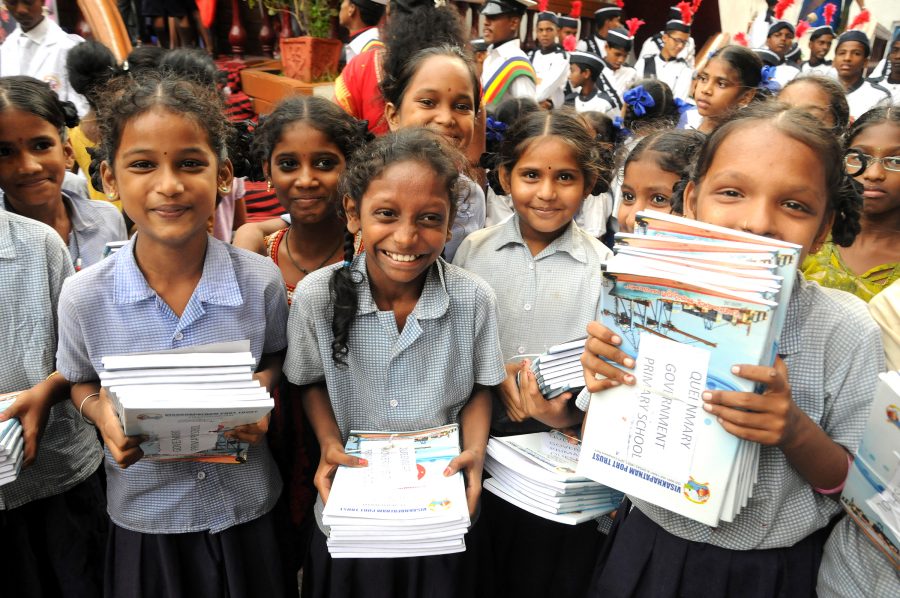
Kerala has emerged as the state with the highest literacy rate in India, yet again. The structural and historical reasons for this achievement are traced back to the 19th century when the queen of Trivandrum decreed the provision of free elementary education to all the people residing in the state. Later kings from the region like the kings of Cochin picked up the baton and set up public schools and promoted elementary education which gathered speed with the Christian missionary projects afterwards. Social reformers of the 20th century furthered these efforts and continued the drive for education among lower caste groups and girls in the region. In independent India, the state of Kerala had already a well-established network of schools focusing on both primary and continuing education. According to the latest NSO (National Statistical Office) survey, at 96.2%, Kerala’s literacy rate is nearly 19% above the national average.
To arrive at this data, the survey calculates the literacy rate among children above seven years of age and takes into account factors such as individual’s reading and writing of language, basic knowledge of arithmetic and science, state’s expenditure on education, enrolment and attendance ratios, status of vocational/technical training, rates of dropouts, provisions of free/subsidised books, stationery and free midday meal schemes, ability of students to operate computers and internet facilities in households among others. Kerala tops in nearly all these indicators which makes its literacy rate higher than the rest of the states.
The state government’s emphasis on educational access to all sections of the society from early 90s helps the statistics to a great extent. Kerala also boasts of a large network of public libraries with a socio-historical legacy of P N Panicker’s Library Movement. Between 1950s and 70s, he travelled extensively to propagate the cause of accessible libraries across the rural areas of the region and set up libraries with assistance from enthusiasts and grants from the government. This cultural movement was key to the eventual accomplishment of universal literacy by the state of Kerala. As of 2018, the Kerala State Library Council recorded an impressive 8417 libraries under it. The Kerala State Literacy Programme initiated by the state envisions that each person be not only numerically and alphabetically literate but also socially literate. The strong system of decentralised administration is in place to ensure the effective implementation of the education programme at the district and local levels.
However, despite the exceptional performance in literacy, there are issues that obstruct the victory from being overtly celebratory. The practical divide between literacy and education suggests that it is not enough to be enrolled into a school, to have the ability to read and write and have equal access to institutional learning. These may be the first significant steps but they are not to be contented with. In higher levels of education, for instance among Kerala’s engineering and medical learning institutions, quality of education has been reported to be very low, especially among the self-financing colleges that are sanctioned by the state government without ensuring adequate infrastructure and academic standards.
This trend has contributed to the growing population of the unemployed and unemployable professional graduates in the state. According to a survey conducted by the Centre for Monitoring Indian Economy (CMIE), as of May 2020, Kerala’s unemployment rate rose by 9.5 % points (from 4.3% in sept 2018 to 26.5% now), greater than the national rate of 23.5%. Another parameter that throws a lingering doubt on Kerala’s literacy performance applause is the quality of research work produced by institutes of higher education. Kerala performs poorly in this measure. And as for the institutes of higher education in the fields of arts, commerce and humanities, the discussion is still at the level of increasing their numbers in the state.
These contradictions raise questions about the relevant impact of having a high literacy rate. While on the one hand, Kerala’s communist legacy of governance has ensured a relatively higher and equitable access to education, nutrition and healthcare among its residents, on the other hand, it hosts a large number of unemployed and unemployable people, owing partly to the low levels of industrial and business development. The lack of sufficient flow of business capital and manufacturing ventures in the state, and very few higher educational institutes of excellence have been attributed to be the causes that sabotage the impact of Kerala’s literacy numbers.













